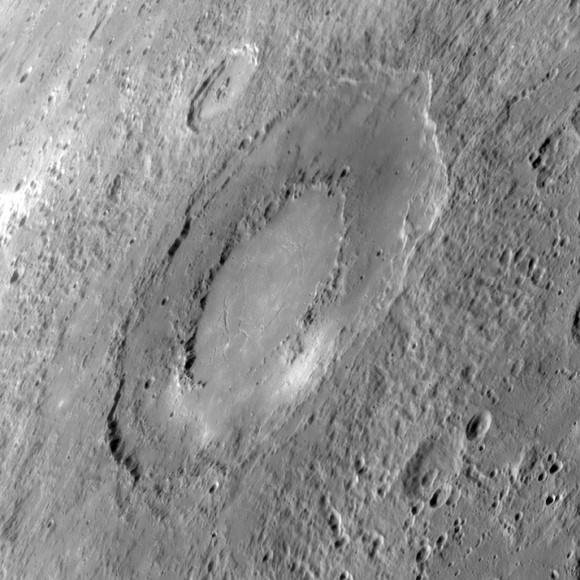[/caption] The MESSENGER spacecraft went into safe mode just before its closest approach of Mercury on Sept. 29. Although the instruments were taking data as the spacecraft came near the planet during this third flyby of the mission, after going into safe mode, no further data or pictures were obtained. This means the expected science investigations from the flyby were not executed. However, as Emily Lakdawalla pointed on in the
Planetary Blog,
the most important purpose of this flyby was the last gravity assist that will allow MESSENGER to enter orbit in 2011, and to that end, the flyby was a complete success. Additionally, the images taken during the approach are of the 5% of Mercury that was previously unseen, as in the image above of this unnamed basin. See more images from the approach below.
[caption id="attachment_41789" align="aligncenter" width="577" caption="A High-resolution Look over Mercury's Northern Horizon. Credit: MESSENGER team"]
[/caption] MESSENGER skimmed just 142 miles (228 km) above Mercury at closest approach, and then whipped behind the planet for the gravity assist. During the operation, five MESSENGER "fellows" or master teachers were reporting the flyby live via Twitter. Gene Gordon (
Porchdragon
on Twitter) reported that unexpectedly, the signal dropped from MESSENGER before the expected signal blackout while flying on the other side of Mercury: "Suddenly room got quiet and people hovering near computers. Unexpected signal drop just occurred. Sense of nervousness seems to have happened."
Read Gene Gordon's blog post about his experiences.
The MESSENGER team had to wait over 50 minutes until the spacecraft emerged from behind Mercury, and were relieved to be able to resume contact. As of Wednesday morning, the spacecraft was operating normally, and the reason for the signal drop was unclear. At a briefing, MESSENGER team members said the spacecraft went into safe mode when it entered Mercury's shadow and tried to switch to battery power. The team is still looking into why this anomaly occurred.
A little less than half of the"extra" science goals for the flyby were accomplished. See our
previous article
on the science goals for the flyby. Following this flyby. only the polar regions of Mercury have never been seen. [caption id="attachment_41788" align="aligncenter" width="580" caption="Previously unseen side of Mercury. Credit: NASA/Johns Hopkins University Applied Physics Laboratory/Carnegie Institution of Washington"]
[/caption] MESSENGER made its closest approach on Tuesday at about 5:55 p.m. EDT (2155 GMT), zooming at speeds of about 12,000 mph (19,312 kph). Mercury's gravity was expected to slow MESSENGER by about 6,000 mph (9,656 kph) during the flyby and place it on track to enter orbit of Mercury in March 2011.
See all the images acquired by the third flyby here.
Learn more about MESSENGER and the two previous flybys which occured in 2008
here.
Lead image caption: his unnamed impact basin was seen for the first time yesterday during MESSENGER's third flyby of Mercury. The outer diameter of the basin is approximately 260 kilometers (160 miles). This basin has a double-ring structure common to basins with diameters larger than 200 kilometers (about 125 miles).
Additional information from Jeff Goldstein on Twitter (
doctorjeff
) was also used in this article
 Universe Today
Universe Today
